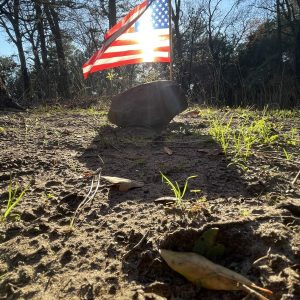
Harold Wells (left) walks James Beavers through the Gay-Hagan Cemetery off Phillip Springs Road. Putting in hours a day across several years, Wells has managed to uncover numerous long-neglected graves at the site, some dating back before the founding of Gladewater. (Photos by James Draper)
For the longest time, it seemed whenever James Beavers walked out on his back porch he’d hear some kind of noise from the supposedly vacant forestland across the way.
When he finally investigated, he came upon Harold Wells in the midst of the thicket. Hefting a gas-powered leafblower, he was painstakingly clearing the forest floor.
Putting in as many as four hours a day seven days a week for the past several years, the former Gladewater mayor has been gradually uncovering the graves of the long-neglected Gay-Hagan Cemetery off Phillip Springs Road. He’s made a sizable dent, but there’s plenty of work left to fully rehabilitate the final resting place of scores of the city’s earliest settlers.
For many, there’s just a rough-hewn stone marking their gravesite, and many of those rocks had been steadily buried over time. Apparently, the last major work at the site was then-Boy Scout Ryan Coker’s Eagle Project in the early ’90s when he cleaned the grove and marked graves with T-bars for future excavators.
Three decades later, Beavers is wow’d by Wells’ solo progress at the site – and frustrated that the 82-year-old’s had to go it alone for so long – and he’s intent to rally others to the task.
The City of Gladewater could pitch in more at the city-owned site, he insists. Organizations could lend a hand. Individuals should pitch in. Funeral homes. Surely, Beavers says, a grant writer could secure just a little bit of the millions of dollars available for such historical preservation work.
Heck, Wells says a front-end loader and a dump truck could make a huge difference in an afternoon.
“He’s not getting paid a penny to do this. It’s all volunteer,” Beaver said. Many hands would make the work light: “Rally the troops.”
It’s easily a labor of love for Wells.
“Each rock is a person.”
Walking through the three-acre grounds, a good portion still obscured by fallen leaves and undergrowth, Wells introduces the families and individuals, recounting details from lives long past.
Research and cemetery ‘reads’ by contributors to the Upshur County and Gregg County TX GenWeb projects has preserved at least some of the information lost to erosion and vandalism.
From available records, the oldest grave in the cemetery is Elvey Shepperd (1779-1860). She reportedly came to Texas from South Carolina in 1845 and built one of the first homes in the area.
A stone’s throw away, Wells notes a pile of rocks that likely indicates the otherwise unmarked graves of other early settlers: slaves brought here by Shepperd.

Marked and unmarked graves, concealed plots and unearthed containers await excavation and, often, identification at Gay-Hagan Cemetery.
“We’ve got one veteran, and he’s up yonder,” Wells said, indicating a small, fresh American flag at the grave of Perry Hewitt, who fought in the Civil War.
Working from Coker’s Eagle Scout efforts as well as other historians’ additions, Wells puts the cemetery’s total count somewhere between 150 and 180 individuals, many of them kin. Naturally, there could be more, lost to time.
“We don’t care. That’s what’s too bad. But it’d be so easy, that’s what bothers me, to get this stuff out of here.”
An entry from 2010 notes a county effort that cleared the way to the cemetery along with brushwork by the City of Gladewater.
Coordinating with City Hall has gotten more brush cleared away in recent years, too, but there’s plenty more where that came from. Wells will take all the help he can get.
“Once I get it cleared, I can just blow it,” he said. Between a leaf-blower, rake, hoe and lots of water, “I’ve about got it where if people wanted to come up here and walk, they could walk along the fence. It’s beautiful down here.”
He’s hoping, at least, people will notice.
Clearly, it’s happened before. There’s evidence of private pains taken to replace old monuments. There are faded funeral home placards in place that preserved old graves. There are the standing T-bars installed by Coker.
And, there’s a growing area, dutifully cleared of debris, primed for more.
– By James Draper










